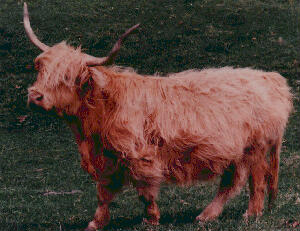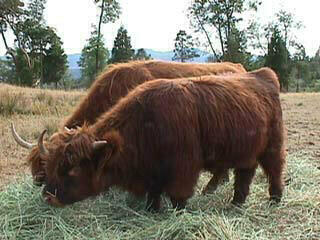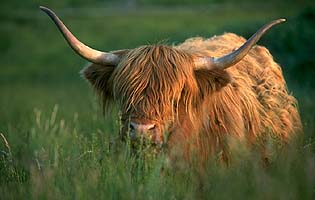
 Highland Cow
Highland Cow

The Highland breed has lived for centuries in the rugged remote Scottish Highlands. The extremely harsh conditions created a process of natural selection, where only the fittest and most adaptable animals survived to carry on the breed.
 Originally there were two distinct classes: the slightly smaller and usually black Kyloe, whose primary domain was the islands off the west coast of northern Scotland; the other, a larger animal generally reddish in color, whose territory was the remote Highlands of Scotland. Today both of these strains are regarded as one breed-the Highland. In addition to the red and black of the original strains, yellow, dun and silver-white are also considered traditional colors.
Originally there were two distinct classes: the slightly smaller and usually black Kyloe, whose primary domain was the islands off the west coast of northern Scotland; the other, a larger animal generally reddish in color, whose territory was the remote Highlands of Scotland. Today both of these strains are regarded as one breed-the Highland. In addition to the red and black of the original strains, yellow, dun and silver-white are also considered traditional colors.
The Highland is the oldest registered breed of cattle, with the first herd book being established in 1884. Today Highlands are found throughout North America, as well as in Europe, Australia, and South America.
Highlands require little in the way of shelter, feed supplements, or expensive grains to achieve and maintain good condition and fitness.
 In fact, Highland cattle seem to enjoy conditions in which many other breeds would perish. Cold weather and snow have little effect on them the Highland is insulated by long hair. Less than ideal pasture or range land is another reason to consider the Highland breed. It has been said that the Highland will eat what other cattle pass by . . . and get fat on it! The Highland is also an excellent browser, able to clear a brush lot with speed and efficiency.
In fact, Highland cattle seem to enjoy conditions in which many other breeds would perish. Cold weather and snow have little effect on them the Highland is insulated by long hair. Less than ideal pasture or range land is another reason to consider the Highland breed. It has been said that the Highland will eat what other cattle pass by . . . and get fat on it! The Highland is also an excellent browser, able to clear a brush lot with speed and efficiency.
In the British Isles, Highland beef is recognized as the finest available and fetches premium prices. The British Royal family keeps a large herd of Highlands at Balmoral Castle, near Braemar, Scotland, and considers them their beef animal of choice.
 Return to the Fridge door
Return to the Fridge door